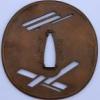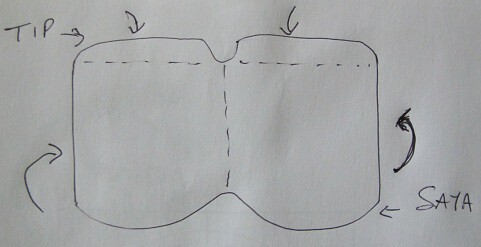-
Posts
867 -
Joined
-
Last visited
-
Days Won
2
Content Type
Profiles
Forums
Events
Store
Downloads
Gallery
Everything posted by Lee Bray
-
Some Tanaka school tsuba use gold on their sekigane. A simple google search will show that. To say that sekigane never had gold on them is wrong. These sekigane show on the inside of the ana if you look carefully. I also see crosshatching under the gold 'splotches'- nunome zogan. Seems to be slight wear in the seppa dai area from mounting. Surface iron doesn't look cast to me. I think this tsuba has been denigrated prematurely. I agree the mei is a little funky looking but nothing else strikes me as fake. Late Edo, maybe later, copy of a Tanaka school tsuba.
-
If it's a trap, lock me in it, cos I'll be happy looking at that superb work all day long. (Hamano?)
-
I think you are wrong, hypothetically. Unless you have made your name over some time selling quality steel, modern swords go for very little. A couple of the best names like Howard Clark and Antony DiCristofano seem to sell with regularity but most sit on their stock for some time. The most active sword forum around is SBG which deals mostly with swords swords below US$300, fully mounted. Chinese forges are knocking them out by the hundreds. One of the most popular low end, fully mounted functional swords sells for US$80! US$80! (repeated for effect) Even custom swords from Chinese forges are selling for a few hundred as opposed to thousands. I think a skillful Chinese smith would welcome the chance to create some slightly better swords for this dubious market. Just look at the nakago on these pieces... my H.Clark and modern Chinese katana have more patina on them and they are just several years old. These nakago that Adrian linked to were filed and stamped last week.
-
No need for alarm, gentlemen. That's silver foil on the nakago. Someone told the op it would highlight the kanji.
-
Hizen (no) Kuni Yoshimune. Late Edo smith, I think.
-

12 swords at auction in New York area
Lee Bray replied to Millsman's topic in Auctions and Online Sales or Sellers
Ron, you bugger, that was me... I couldn't translate the mei on the Tanaka school tsuba...anyone out there tell me what it was? A friend of mine had a bid on that sword but as we couldn't recognise the name and I thought the work wasn't great for that school, we only bid low. Surprised that it went for 4k...bit of a gamble unless it's one of the better names in the school. -

translation/identification assistance help please!
Lee Bray replied to awhitetriangle's topic in Translation Assistance
Here you go - http://www.joelscoins.com/Japan.htm Scroll down a little and you'll see your piece. -
Ron, the dragon kojiri on my wakizashi is formed in two separate halves and soldered/brazed together. Edit - The two halves aren't separate, rather it's a one piece construction, folded in the centre with the top and side brazed together.
-
Here's a reasonable, almost complete set on a wakizashi of mine. https://picasaweb.google.com/1083860067 ... sGU8vnx4gE Fuchi, kashira, kuchigane and kojiri are matching but the kurikata and the cap on the kodzuka slot were missing. Menuki are of shakudo and the tsuba that came with it originally didn't match or fit so I replaced it with the current piece.
-

Do you use your nihonto for tameshigiri?
Lee Bray replied to Hans Kondor's topic in General Nihonto Related Discussion
If anyone has a burning desire to cut bamboo, we have plenty of it growing wild. If you want to cover my time and shipping, I'd be happy to chop some down and send it on. From arrow bamboo of up to 1cm thick to timber bamboo of up to 15cm thick(hard to come by), we have most varieties. Common type is around 3cm to 5cm and has two varieties; thick wall ~ 8mm and thin wall ~4mm. Unsure on maximum shipping lengths but 4ft should at least be doable as I've shipped 4ft packages before. Just a thought in case anyone was interested. -
Hi Stephen, Regarding shipping swords to China, don't do it. If your bidders have Hong Kong addresses, then that is fine. I live in Hong Kong and have received swords shipped from the states with no problems, perfectly legal. If you have any questions, feel free to ask. Best of luck with the auction.
-
I have no problem with the modern NBTHK system and have happily sent in swords for hozon papers but resubmitting the Shigetaka would be pointless as it is gimei. Removing the mei is an option but not a cheap one, especially with both sides of the nakago needing to be worked on. As it is, I'll keep it as a good example of why you buy the sword, not the papers.
-
Hi Denis, Glad I altered your perception of the 'Godly' papers - even the modern NBTHK and NTHK papers should be treated as opinions, albeit extremely good ones. As Jacques points out, there's always room for doubt.
-
Sorry it went unanswered...different time zones and sleep. I'm confused (possibly by the question mark after my name). I'm not asking members for their opinion on my sword, I'm just presenting it as evidence that kicho papers are not worth the time spent discussing them. I referred Geraint to a search because he sounded interested in Shigetaka but I didn't have the link to hand and I was pressed for time. Given the doubt around kicho papers, my initial point is I wouldn't trust what they said. In your position, I would not believe the Kanetane attribution and would submit for hozon. If a low ranked smith such as Shigetaka 6th gets fake papers it raises too many questions on the integrity of the whole system. At least it does for me, but then I bought the blade based on the advice of buying polished, papered blades so now I'm rather jaded on kicho papers.
-
Hi Geraint. There are pics of the mei and papers somewhere on this board if you do a search. The blade is dated to 1663 and part of the mei says roku dai, or sixth generation, yet the nidai worked in that time period and the 6th worked in 1740's. Because of the time difference, I sent hi-res pics of the mei and date to a couple of dealer associates in Japan and both thought it gimei. Good questions regarding the reasoning behind the gimei/papers. I've never understood it myself.
-
I have an Echizen Shigetaka 6th gen in Japanese polish from a dealer in Japan with kicho papers and it is gimei. The kicho papers are genuine but not worth the paper they're printed on. If I had a mumei sword with kicho papers, I would send it for Hozon just because I have zero faith in kicho papers.
-

Special NMB Member dicount to nihontoart.com
Lee Bray replied to Nickupero's topic in Auctions and Online Sales or Sellers
Very commendable and generous of you, Sir. Is there/should there be a minimal post count to qualify for these generous discounts or can I join NMB tomorrow for my 10%? -
Thanks very much for the translation, Morita-san.
-
Having trouble with the smith name, possibly Uemon, but doesn't seem correct. I have Kyushu Higo Dotanuki - the remaining four kanji are the smith's name, I believe. X X X Mon. Thanks for any help.
-

Feelings on "dressing out" a Nihonto?
Lee Bray replied to Ken-Hawaii's topic in General Nihonto Related Discussion
A year? Ford's tsuba and fuchigashira in the classifieds at the moment with Higo shaped, doeskin wrapped tsuka and a saya of Kens' choice, preferably not black. There...only took a minute... -
Chatting with Tsuruta-san of Aoi art last year, he said that tanto were preferred by older Japanese collectors because they were much easier to physically handle.
-
Other side, Henry. I thought the same as you but there is a plugged ana under the inlaid Samurai. I wonder if the plugged ana was a mistake at the time of making? The tsubashi just cut the ana on the wrong side. The mounted Samurai looks part of the original design and as it is inlaid into the plug, the plug must have been there from the start.
-
Hi Brian, Don't be too zealous with the cleaning, especially if you're using uchiko. I live in Hong Kong which is permanently humid and lots of rain. My house is an old fish farmers house and has four derelict fish ponds 15ft from the back wall. It is bordered on two sides by wetlands and a hilly wood to the last side. Suffice to say it is very wet. I use AC and a dehumidifier and still occasionally have issues with books and clothes getting moldy but so far, I have not had any swords develop rust because of it. I've had the silk ito on tsuka get moldy so now keep koshirae in silk sword bags, which although still silk, seems to keep the tsuka safe. My swords tend to be oiled once every couple of months and I've had no issues with rust over the years if kept housed in shirasaya or saya. Of course, when you're studying them a lot, they need cleaning after use so try and use isopropyl alcohol to clean the oil off when viewing them instead of uchiko if the blade is in good polish.




